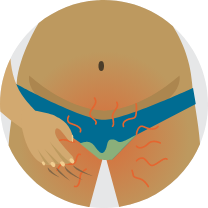
What is it?
Chlamydia is a bacterial infection that can cause pain, burning, or itching in the penis, vagina, or anus. It can also cause unusual liquids (discharge) to come out of the penis, vagina, or anus.
How can you get it?
You can get chlamydia through vaginal or anal sex with a partner who has chlamydia. The infection is transmitted when your vagina or anus comes into contact with your partner’s sexual fluids. Sexual fluids include ejaculate, vaginal fluid, and anal fluid. Chlamydia may also be spread through oral sex on a penis, though this is not common.

How do you know if you have it?
Many people do not show any signs of chlamydia. This is especially true if the infection is in the mouth, vagina, or anus. When you do show signs, they can include:

Testing
Testing for chlamydia involves peeing in a cup. Your urine will be sent to a lab for testing. If you have signs such as unusual discharge, your healthcare provider may also take a swab using a long q-tip or tiny brush. Most tests give accurate results 2 weeks after the sex act that may have exposed you to chlamydia.

Treatment
Antibiotics cure the infection completely if taken properly. Be sure to take the medication as directed by your healthcare provider and finish all the pills in the bottle.

Prevention
You can reduce your risk of getting chlamydia by using barriers such as condoms and dental dams during oral, vaginal, and anal sex. You can also choose to engage in sexual activities that do not pose a high risk for spreading chlamydia such as giving or receiving a massage, mutual masturbation, or oral sex. You and your partner can get tested before engaging in sexual activity to ensure neither of you has chlamydia.







